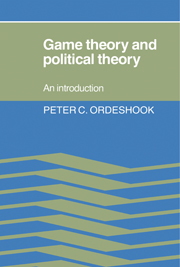Book contents
- Frontmatter
- Contents
- Preface
- Acknowledgments
- 1 Individual preference and individual choice
- 2 Individual preference and social choice
- 3 Basic theory of noncooperative games
- 4 Elections and two-person zero-sum games
- 5 Nonzero-sum games: political economy, public goods, and the prisoners' dilemma
- 6 Institutions, strategic voting, and agendas
- 7 Cooperative games and the characteristic function
- 8 The core
- 9 Solution theory
- 10 Repeated games and information: some research frontiers
- References and a guide to the literature
- Index
7 - Cooperative games and the characteristic function
Published online by Cambridge University Press: 21 March 2010
- Frontmatter
- Contents
- Preface
- Acknowledgments
- 1 Individual preference and individual choice
- 2 Individual preference and social choice
- 3 Basic theory of noncooperative games
- 4 Elections and two-person zero-sum games
- 5 Nonzero-sum games: political economy, public goods, and the prisoners' dilemma
- 6 Institutions, strategic voting, and agendas
- 7 Cooperative games and the characteristic function
- 8 The core
- 9 Solution theory
- 10 Repeated games and information: some research frontiers
- References and a guide to the literature
- Index
Summary
The preceding chapters have gone to extraordinary lengths to avoid the possibility that people cooperate and act in concert to achieve some outcome. Chapter 2 describes logrolling as an example of strategic voting without supposing that a decisive subset of the legislature such as a majority acts to thwart the vote trades that other members of the legislature might negotiate. Chapter 4 analyzes elections as noncooperative games between candidates; this approach seems appropriate for two-candidate elections, but it also assumes that voters are passive agents in the election and it thereby ignores the coalitions among voters that interest groups, such as organized labor, try to form. Chapter 5 applies the prisoners’ dilemma to a variety of situations, but it does not allow people to try to avoid mutually distasteful outcomes by some form of prior, binding collusion. And Chapter 6 dispassionately analyzes issue-by-issue voting in committees by assuming that members cannot talk, negotiate, and coordinate their strategies, thereby precluding the important possibility that procedures affect outcomes only if members choose not to collude to bypass them.
The assumption that people reveal their strategies simultaneously and cannot communicate their choices beforehand is a useful theoretical abstraction. Many two-person situations are best modeled as zero-sum games, in which case communication serves no purpose, and it is useful in other circumstances to evaluate the consequences of the failure to communicate. It is probably rare, though, that communication among people, however imperfect, remains impossible. In response to this reality, cooperative game theory models those situations in which communication not only is possible, but also stands as a central feature of human interaction.
Information
- Type
- Chapter
- Information
- Game Theory and Political TheoryAn Introduction, pp. 302 - 338Publisher: Cambridge University PressPrint publication year: 1986
